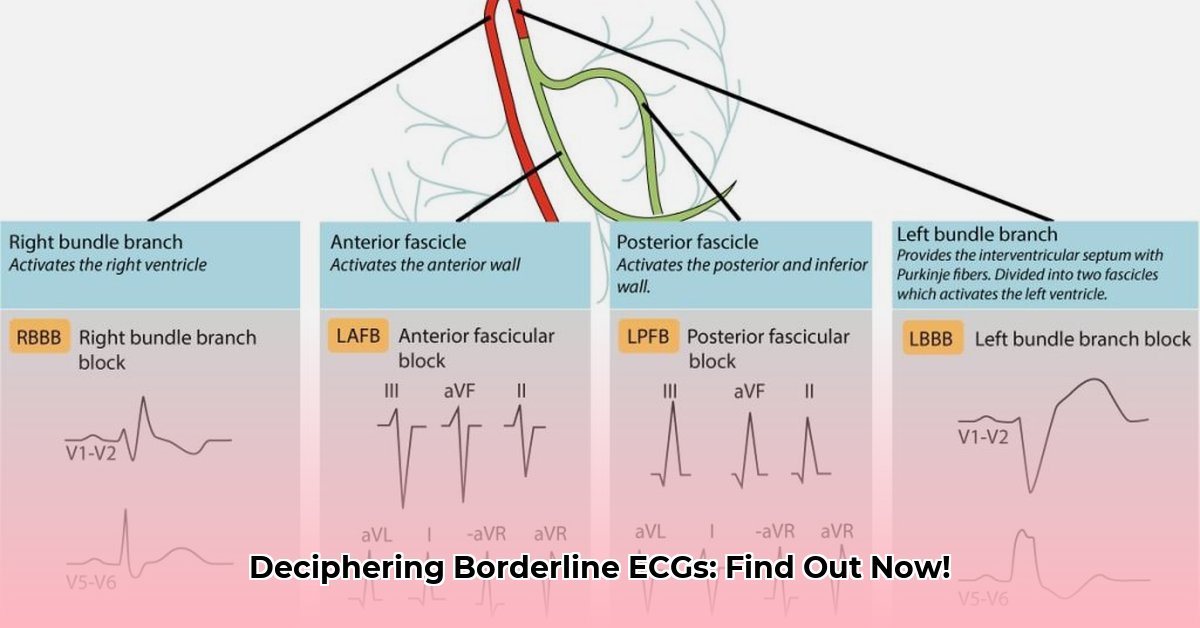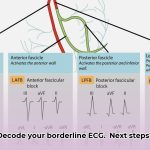Got a borderline ECG result and feeling a little lost? It’s completely normal to feel unsure when you get medical test results that aren’t perfectly clear. This guide is here to help you understand what a borderline ECG means, what to expect next, and how to work with your doctor to take care of your heart. We’ll break down everything in simple terms, so you feel empowered to take the right steps. For more information, see this helpful guide on borderline ECG next steps. Let’s get started on understanding your results and making a plan for your heart health.
Borderline ECG Next Steps: Your Action Plan
Getting a “borderline” result on your electrocardiogram (ECG) can feel a bit like getting a cryptic message. It means your heart rhythm showed something a little unusual, but not something clearly defining a problem. Don’t worry – it’s not a diagnosis, just a signal to investigate further. Let’s break down what that means and what you can expect next.
Understanding Your Slightly-Off ECG
Think of your heart as a finely tuned machine. Your ECG is a snapshot of its electrical activity. A borderline result means the snapshot shows something a little out of the ordinary, but it doesn’t tell the whole story. It’s like finding a single misplaced tile in a huge mosaic – you know something’s slightly off, but you need to look closer to see the bigger picture and if it truly matters.
Many things can cause a slightly irregular ECG reading. Sometimes, it’s nothing to worry about – maybe you were stressed, dehydrated, or had too much caffeine that day. Other times, it might suggest something that needs more attention. The important thing is to figure out what’s going on. A study published in the Journal of the American College of Cardiology showed that up to 20% of ECGs may show borderline results, highlighting the importance of proper follow-up.
What Could Be Affecting Your ECG Results?
Several things can influence the results of your ECG. Let’s explore some possibilities:
- Your Lifestyle: Stress, lack of sleep, too much caffeine or alcohol, even smoking—these things can temporarily mess with your heart’s rhythm. Think of it like overclocking your computer; it might work fine for a short time, but it’s not ideal. Aim for at least 7-8 hours of sleep per night, and limit caffeine intake to no more than 400mg per day (about 4 cups of coffee).
- Your Medications: Some medications, such as decongestants or certain antidepressants, can affect your heart rate and rhythm. It’s always a good idea to discuss any medications with your doctor, especially if you’ve recently started new ones or changed dosages. Bring a complete list of all medications and supplements to your appointment.
- Electrolyte Balance: Electrolytes like potassium, sodium, and magnesium are crucial for your heart’s function. An imbalance can show up on your ECG. Think of them as the essential oils keeping your heart’s engine running smoothly. Good sources of potassium include bananas, spinach, and sweet potatoes.
- The Test Itself: Sometimes, it’s not your heart, but the way the ECG was taken. A slight movement or a poor connection can produce a slightly off reading. A repeat test could clarify things and offer a better picture. A properly administered repeat ECG can improve accuracy.
- Underlying Health Conditions: In some cases, a borderline ECG might be a clue pointing towards a more significant heart-related issue or other underlying medical condition, such as hyperthyroidism or sleep apnea. This is where further investigation becomes essential.
Next Steps After Your Borderline ECG
The best way forward depends on several factors – your symptoms (or lack thereof!), your medical history, and what your doctor thinks. Here’s a likely plan:
Step 1: Talk to Your Doctor: This is the most crucial step. Your doctor will review your ECG results alongside your overall health history and any symptoms you’ve been experiencing. They will help interpret the results in context with everything else. Be prepared to discuss any chest pain, palpitations, shortness of breath, dizziness, or fainting spells.
Step 2: Further Testing (Possibly): Depending on the initial assessment, more tests might be recommended to check everything:
- Another ECG: This is a simple way to see if the first reading was indeed accurate. Sometimes, a repeat is all it takes.
- Holter Monitor: You’ll wear a small, portable device that records your heart rhythm continuously for 24-48 hours. This is helpful if issues are intermittent. It’s important to keep a diary of any symptoms experienced while wearing the monitor.
- Echocardiogram (Echo): This is like an ultrasound for your heart. It uses sound waves to create detailed images of your heart’s structure and function.
- Stress Test: This measures how your heart responds to physical exertion or medication that mimics exertion, helping to identify any weaknesses under stress. There are different types of stress tests, including exercise stress tests and pharmacological stress tests.
- Blood Tests: These might check for electrolyte imbalances or other things that could be contributing to irregular heart rhythms, such as thyroid function.
- Cardiac CT/MRI: In some cases, more advanced imaging may be necessary to evaluate the heart’s structure and function in detail.
Step 3: Lifestyle Adjustments (Possibly): Your doctor might suggest simple lifestyle changes. These can include stress reduction techniques, better sleep habits, a healthier diet, and adjustments to medication. Simple changes might be enough to set things right. Consider incorporating regular physical activity (at least 150 minutes of moderate-intensity exercise per week), a balanced diet, and stress-reducing activities.
Step 4: Specialist Referral (Possibly): In some cases, your family doctor might refer you to a cardiologist, a heart specialist. This is especially likely if you have symptoms, risk factors for heart disease, or if the further tests reveal concerns.
What to Expect from a Cardiologist
If you see a cardiologist, expect a thorough evaluation. They’ll take a careful look at your ECG and other test results. They can order more tests or, if needed, create a personalized treatment plan. This might include medications, lifestyle recommendations, or even interventional procedures.
A Positive Perspective on Your Heart Health
Remember, a borderline ECG doesn’t automatically mean you have a serious heart problem. The next steps are all about getting a clearer picture and ensuring your heart health is what it should be. Open and honest communication with your healthcare provider is key.
Weighing the Risks of Further Testing
It’s essential to understand that while the tests are relatively safe, all medical procedures carry some small risks. It’s important to weigh these risks against the benefits of accurate diagnosis.
| Technology/Procedure | Risk of Misdiagnosis | Risk of Delayed Treatment | Common Risks |
|---|---|---|---|
| Repeat ECG | Very Low | Very Low | None |
| Holter Monitor | Very Low | Low | Skin irritation from electrodes |
| Echocardiogram | Low | Low | None |
| Stress Test | Low | Low | Chest discomfort, shortness of breath, rare risk of cardiac event |
| Blood Tests | Very Low | Very Low | Bruising, infection at the needle site |
| Cardiac CT | Very Low | Very Low | Radiation exposure, allergic reaction to contrast dye |
| Cardiac MRI | Very Low | Very Low | Claustrophobia, reaction to contrast dye |
The goal is proactive health management, not panic. By working closely with your doctor, you can gain a much clearer understanding of your heart’s health and take the appropriate steps to ensure that you’re getting the best care. Remember, your health is worth it!
How to interpret borderline ECG results and determine necessary next steps
Key Takeaways:
- A borderline ECG isn’t a diagnosis, but a signal for further investigation.
- Many factors can cause borderline results, from simple issues to serious heart problems.
- Your doctor will use your history, physical exam, and other tests to understand your ECG.
- Lifestyle changes can improve heart health, regardless of your ECG.
- Staying informed and working with your doctor is crucial.
Understanding Borderline ECG Findings
Have you received a borderline electrocardiogram (ECG) result? It’s understandable to feel confused. A borderline ECG means the test shows something slightly unusual, but isn’t conclusive enough for a diagnosis. Think of it like a blurry photograph – you see something, but it’s not clear enough to say for sure what it is. This requires further investigation.
What causes these ambiguous readings? Several factors might be at play. Sometimes, it’s due to simple factors like stress, dehydration, or even the way the test was performed. Other times, it could hint at underlying heart conditions requiring attention. That’s why it’s critical to discuss your results with a doctor.
Determining the Next Steps
How to interpret borderline ECG results and determine necessary next steps involves a multifaceted approach. Your doctor uses a combination of several tools:
- Patient History: Your medical history is crucial. Do you have a family history of heart disease, arrhythmias, or sudden death? Do you experience symptoms such
- Wellness Fair Ideas for Work to Boost Employee Wellbeing - December 15, 2025
- Affordable Employee Wellness Fair Ideas for Any Budget - December 14, 2025
- Employee Wellness Programs Strategically Benefit Employee Health And Retention - December 13, 2025
















